Text
Benefits of Physiotherapy for Treating a Sprained Ankle

A sprained ankle is quite a common injury that can cause pain, swelling, and limited mobility. While rest and ice are initial treatments, physiotherapy offers a comprehensive approach to healing and rehabilitation. To alleviate the symptoms of a sprained ankle, you need to be patient and work with physiotherapy on your fingernails. And that is what would give you a place where the sprained ankle would eventually heal.
In this blog, we'll explore the five key benefits of physiotherapy for treating a sprained ankle, highlighting its effectiveness in promoting recovery and preventing future issues.
The 5 Benefits of Physiotherapy for Treating a Sprained Ankle
You can treat a sprained ankle in a lot of different ways but what is chosen the best is, choosing to treat it with physiotherapy. There are certain reasons why we recommend that. Let’s see into it:
Pain Management

Physiotherapy actually employs various techniques to manage pain associated with a sprained ankle, including manual therapy, modalities such as ultrasound or electrical stimulation, and therapeutic exercises. By addressing pain early in the recovery process, physiotherapy helps patients regain comfort and mobility more quickly.
Prevents Joint Stiffness

You might face the issue of an immobilized ankle. Such an ankle might come following a sprain and can lead to joint stiffness and decreased range of motion. The job of physiotherapy is to focus on preventing stiffness through gentle mobilization exercises and stretching routines. By maintaining flexibility and joint mobility, physiotherapy ensures a smoother recovery and reduces the risk of long-term complications.
Enhances Functional Abilities

Restoring functional abilities, such as walking, standing, and balance, is a primary goal of physiotherapy for sprained ankles. Through progressive exercises and functional training, physiotherapists help patients regain strength, stability, and coordination, enabling them to return to their daily activities with confidence.
Customized Treatment Plans
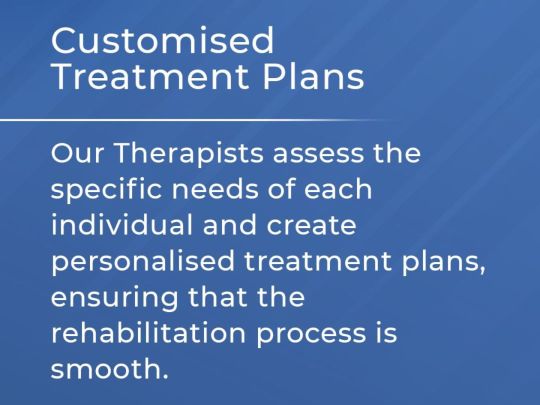
Physiotherapy for a sprained ankle is not a one-size-fits-all approach. Each patient's injury severity, mobility, and goals are unique, requiring personalized treatment plans. Physiotherapists assess individual needs and design customized rehabilitation programs tailored to address specific deficits and promote optimal recovery.
Monitoring Progress

Regular monitoring of progress is quite one of the integral to the success of physiotherapy for a sprained ankle. In the procedure, physiotherapists track improvements in pain levels, range of motion, strength, and functional abilities throughout the rehabilitation process. Once the thing is completely and closely monitored, adjustments can be made to the treatment plan as needed, ensuring continued advancement towards full recovery.
In a Nutshell
Physiotherapy is the type of therapy which plays a very crucial role in the comprehensive treatment of a sprained ankle. It would offer benefits such as pain management, prevention of joint stiffness, enhancement of functional abilities, personalized treatment plans, and ongoing progress monitoring. After incorporating physiotherapy into their recovery process, individuals with sprained ankles can expedite healing, regain mobility, and minimize the risk of future complications.
FAQs on The Benefits of Physiotherapy for Treating a Sprained Ankle
How soon after a sprained ankle should I start physiotherapy?
Physiotherapy for a sprained ankle can typically begin as soon as the acute pain and swelling subside, usually within a few days to a week after the injury. However, the timing may vary based on individual circumstances, and it's essential to follow the guidance of a healthcare professional.
Can physiotherapy help prevent recurring ankle sprains?
Yes, physiotherapy can help prevent recurring ankle sprains by addressing underlying factors such as muscle weakness, poor balance, and faulty movement patterns. Through targeted exercises and functional training, physiotherapy strengthens the ankle and surrounding muscles, improving stability and reducing the risk of future injuries.
How long does it take to recover from a sprained ankle with physiotherapy?
The recovery time for a sprained ankle varies depending on the severity of the injury and individual factors such as age, overall health, and adherence to the treatment plan. With physiotherapy, most individuals can expect significant improvement within a few weeks to a couple of months, although full recovery may take longer for more severe sprains.
Book your first appointment with us today!
0 notes
Text
The 4 Benefits of Physiotherapy for Arthritis

Living with arthritis can be challenging. It brings in the body, pain, stiffness, and reduced mobility. While on one hand, medications can provide relief, it becomes not entirely curable in the long. But on the other hand, you can try using physiotherapy as it offers additional benefits that may not be immediately obvious.
In this blog, we'll uncover four surprising benefits of physiotherapy for arthritis that go beyond pain management and joint exercises.
The Hidden 4 Benefits of Physiotherapy for Arthritis
Arthritis is one of the most common problems people face on an everyday basis. Besides causing pain, it stands as the reason why people face issues like reduced mobility and eventually, that leads to a degradation in their entire well-being. Here’s how you can use physiotherapy as an ailment for your arthritis issues:
Joint Mobility and Flexibility
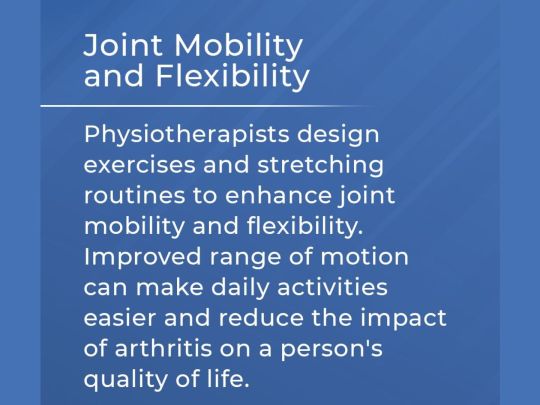
Physiotherapy focuses on improving joint mobility and flexibility through targeted exercises and stretching routines. For an arthritis patient, you might have painful joints that would not provide you the strength the move on a general basis and this would help you. These exercises help lubricate the joints, reduce stiffness, and increase the range of motion. By enhancing joint function, physiotherapy gives the smooth ability to arthritis patients to perform daily activities with greater ease and comfort and lesser pain eventually.
Weight Management

Excess weight increases symptoms by placing additional stress on the joints. This leads to increased pain and inflammation. Physiotherapy isn’t just a set of exercises but it also provides education and guidance on weight management strategies, such as dietary modifications and personalized exercise plans. It would help you balance weight. And thus, in the long run, alleviate arthritis pain.
Posture and Body Mechanics

Poor posture and improper body mechanics can actually contribute to joint strain and exacerbate arthritis symptoms. Physiotherapy addresses these issues in a way. It teaches you proper body mechanics and posture techniques. By such optimization of body alignment and movement patterns, arthritis patients can reduce joint stress and minimize pain during daily activities.
Psychological Well-Being

Living with chronic pain and limited mobility can take a toll on mental health, leading to feelings of frustration, anxiety, and depression. Physiotherapy provides a supportive environment where arthritis patients can receive emotional encouragement and coping strategies. Engaging in regular physical activity also releases endorphins, which are natural mood boosters, promoting a positive outlook and improved psychological well-being.
FAQs on Benefits of Physiotherapy for Arthritis:
Is physiotherapy safe for all types of arthritis?
Physiotherapy can be beneficial for various types of arthritis, including osteoarthritis, rheumatoid arthritis, and psoriatic arthritis. However, treatment approaches may vary depending on the specific type and severity of arthritis. It's essential to consult with a qualified physiotherapist who can tailor the treatment plan to individual needs and conditions.
How long does it take to see results from physiotherapy for arthritis?
The timeline for seeing results from physiotherapy can vary depending on factors such as the severity of arthritis, adherence to the treatment plan, and individual response to therapy. Some patients may experience improvement in symptoms within a few weeks, while others may require longer-term therapy for sustained benefits.
Can physiotherapy prevent arthritis progression?
While physiotherapy cannot cure arthritis, it can help manage symptoms, slow disease progression, and improve overall function and quality of life. By addressing underlying factors such as joint stiffness, muscle weakness, and poor posture, physiotherapy aims to minimize the impact of arthritis on daily activities and joint health.
Learn about the importance of posture and body mechanics to minimise joint strain, and discover how physiotherapy contributes not only to physical well-being but also to psychological health.
Embrace a comprehensive approach to arthritis care with personalised exercises, weight management, and mental well-being support from skilled physiotherapists at TSquared Physiotherapy.
Book your first appointment with us today!
0 notes
Text
The Benefits of Physiotherapy for Senior Citizens That Reduce Stress

As we age, we find that maintaining physical health becomes an issue over time. And thus, working on it seems like a must, to alleviate oneself from pain and all the other health issues. You generally look for options to help you. For some, it can be exercise, while others resort to therapy. In that sense, physiotherapy offers a holistic approach. It helps you to improve mobility, manage pain, and enhance quality of life. That’s why in this blog, we'll delve into the four best benefits of physiotherapy for senior citizens, with a particular focus on how these benefits contribute to stress reduction.
The 4 Best Benefits of Physiotherapy for Senior Citizens
Senior citizens must not be treated as young adults. They have a whole different set of issues that would have to be fixed otherwise in the long run they might be continuously on the run to fix it. Keeping in mind such a fact, one has to remember while working with a senior citizen, you must have a different approach to physiotherapy:
Pain Management
Chronic pain is a common issue among senior citizens. This often leads to decreased mobility and reduced quality of life. Physiotherapy employs various techniques that include targeted exercises, manual therapy, and modalities like heat and cold therapy, to manage pain effectively. Once you address the root cause of pain and promote healing, physiotherapy can significantly reduce stress associated with chronic discomfort.
Improved Mobility and Flexibility
Age-related issues cause changes in joints, muscles, and bones and can impact mobility and flexibility, making everyday activities challenging and frustrating. Physiotherapy can be the solution to such issues since it focuses on restoring and enhancing movement through tailored exercise programs and stretches. By improving mobility and flexibility, seniors can regain independence, which can alleviate stress related to feelings of dependency and limitation.
Prevents the Risk of Falls
Falling randomly is a significant concern for senior citizens and can lead to serious injuries and loss of confidence. And this mainly arises from the fact they don't have enough strength to grip onto something. It is a hidden mobility issue most senior citizens face. Physiotherapyplays a crucial role in fall prevention by assessing balance, strength, and gait, and implementing exercises to improve these areas. Enhancing balance and coordination can reduce the risk of falls, providing seniors with peace of mind and reducing stress associated with the fear of falling.
Rehabilitation after Surgery or Injury
Surgery or injury can significantly impact a senior's physical function and quality of life. Physiotherapy is deemed essential in the rehabilitation process because it helps seniors regain strength, mobility, and function following surgery or injury. Through personalized rehabilitation programs which are tailored to an individual’s needs, since each surgery requires a different approach and in this way, physiotherapists guide seniors through exercises and therapies to promote recovery and restore independence.
Summary
Physiotherapy is a therapy that offers numerous benefits for senior citizens, ranging from pain management and improved mobility to fall prevention and rehabilitation after surgery or injury. By addressing these aspects of physical health, physiotherapy contributes to stress reduction by enhancing quality of life, promoting independence, and restoring confidence in seniors' abilities to navigate daily activities.
FAQs on the Benefits of Physiotherapy for Senior Citizens
How often should senior citizens undergo physiotherapy sessions?
The frequency of physiotherapy sessions for seniors depends on individual needs, health conditions, and treatment goals. Generally, initial sessions may be more frequent, gradually tapering off as progress is made. A physiotherapist will assess each senior's situation and recommend an appropriate treatment plan.
Is physiotherapy suitable for all senior citizens, regardless of their physical condition?
Physiotherapy can benefit most senior citizens, but the treatment approach may vary based on individual health conditions and limitations. A qualified physiotherapist will conduct a thorough assessment to determine the most suitable interventions for each senior, ensuring safe and effective treatment.
Can physiotherapy help with cognitive health in addition to physical health?
While physiotherapy primarily focuses on physical rehabilitation and function, certain interventions may indirectly benefit cognitive health. Improved mobility, increased social interaction during therapy sessions, and enhanced overall well-being can have positive effects on cognitive function. However, specific cognitive therapy may be required for seniors with cognitive impairments.
Learn more at TSquared Physiotherapy Blog
0 notes
Text
Did You Know About These 3 Benefits of Massage Therapy?

Massage therapy is often seen as a luxurious indulgence, which shouldbe reserved for special occasions or spa days. But that is never the case. Beyond the relaxation it offers, massage therapy holds numerous benefits for both physical and mental health. And there are numerous ways physiotherapy can be beneficial. But most of them are hidden and not known to many. Thus, in this blog, we'll explore three surprising benefits of massage therapy that you may notbe aware of.
The 3 Benefits of Massage Therapy You Didn’t Know Of!
Now there are a bunch of benefits that can be gained from physiotherapy. The most important of them all is the growth of overall well-being. But let’s take a look at the ones so rarely heard of:
Boosts the Immune System
Massage therapy has been, over the years, found people being aided with a relaxing moment. But there’s more to just that. There’s a lot of research that suggests that regular massage sessions can increase the activity level of white blood cells, which play a crucial role in defending the body against illness and disease. By working on the immune function of the body, massage therapy can also help you stay healthier. In such a way, you will help yourself ward off common infections more effectively.
Helps in Reducing Stress
One of the most well-known benefits of massage therapy is its ability to reduce stress levels. Beyond the therapy being a temporary escape from the pressures of daily life, it also has another work. Massage has been shown to lower the body's cortisol levels while increasing the production of serotonin and dopamine, neurotransmitters which are associated with feelings of relaxation and well-being. This can thus, lead to long-term stress reduction and improved mental health.
Improvement in Sleep Cycle
If you struggle with sleep disturbances or insomnia, massage therapy may offer some relief. This is another benefit you didn’t know would exist. It is proven that massage can help promote relaxation and alleviate muscle tension, leading to improved sleep quality. This works by calming the nervous system and inducing a state of relaxation. And that is the way massage therapy can help you fall asleep faster, stay asleep longer, and feel refreshed.
Why is Massage Therapy Important?
Massage therapy is quite important because it actually addresses both physical and mental aspects of well-being, leading to the promotion of overall well-being. In today's fast-paced world, where stress and tension are prevalent, taking care of both our bodies and minds is quite essential for maintaining overall health and vitality. By incorporating massage therapy into your self-care routine, you can reap benefits like improved immune function, reduced stress, and better sleep that would ultimately lead to a happier and healthier life.
FAQs
How often should I get a massage for maximum benefits?
The frequency of massage therapy sessions can vary depending on individual needs and preferences. Some people may benefit from weekly sessions, while others may find that bi-weekly or monthly massages suffice. It's essential to listen to your body and consult with a qualified massage therapist to determine the optimal frequency for you.
Are there any contraindications for massage therapy?
While massage therapy is generally safe for most people, there are certain conditions for which massage may not be recommended or may require modifications. These include certain medical conditions, recent injuries, or acute illnesses. It's crucial to inform your massage therapist about any health concerns or conditions you have, to ensure a safe and effective treatment.
What type of massage is best for stress relief?
Various types of massage, such as Swedish massage, deep tissue massage, and aromatherapy massage, can effectively relieve stress. The best type of massage for you will depend on your specific preferences and needs. It's importantto communicate with your massage therapist about your goals for the session so they can tailor the treatment accordingly.
0 notes
Text
5 Transformative Benefits of Stretch Therapy
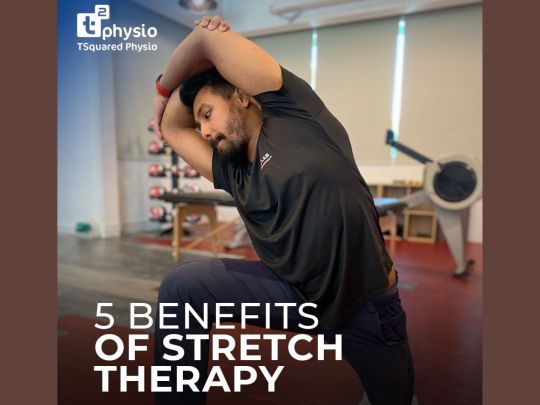
Stretch Therapy is like giving your body a big, warm hug.
Did you know the benefits of stretch therapy?
Stretch therapy is all about boosting flexibility, movement, and feeling great from head to toe through some seriously awesome stretching techniques. Stretch therapy is all about getting your muscles moving in fun and dynamic ways- something that can promote your overall well-being.
Do you know how it promotes overall well-being? It's packed with a bunch of benefits you didn’t know of. First off, it helps you get super bendy and flexible, so you can move with enhanced muscular coordination and avoid those pesky injuries. Plus, it's like hitting the reset button for your muscles, melting away tension and helping you feel relaxed and laid back.
By targeting those tight spots and giving your muscles some love, stretch therapy can have you standing tall and having a great posture at the same time.
But there are a few more benefits to this form of therapy, let’s have a look into that.
Benefits Of Stretch Therapy You Should Know of
Stretch therapy has quite a few advantages. But unfortunately, it is heavily misunderstood and undervalued. Let’s look into those benefits most people ignore:
Better Muscle Coordination
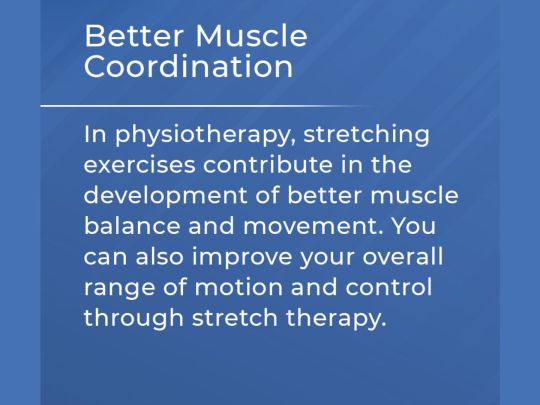
Stretch therapy enhances muscle coordination by promoting better communication between muscles and nerves. Through targeted stretches, you engage various muscle groups, encouraging them to work together more efficiently. This coordination not only improves athletic performance but also reduces the risk of injury during physical activities.
Your muscles are just like a team of synchronized dancers, moving in harmony to perform a flawless routine. Stretch therapy helps them rehearse and perfect their moves, ensuring smooth and coordinated actions in all your activities.
Improvement of Blood Circulation and Nutrition Supply
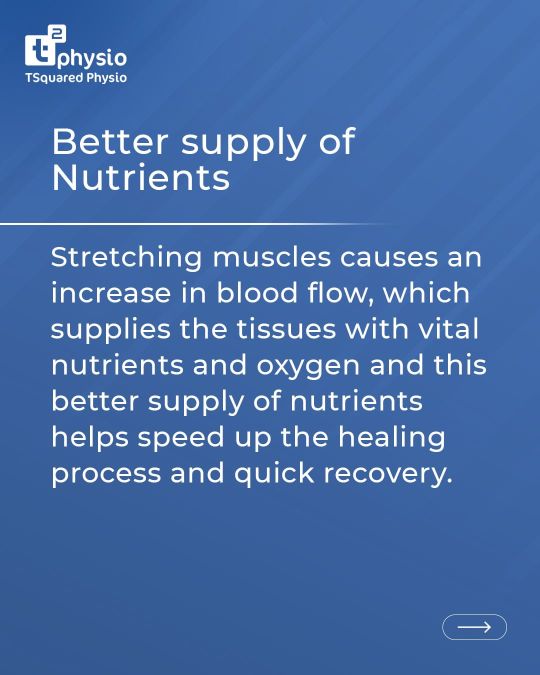
Stretching increases blood flow towards your muscles, delivering essential nutrients and oxygen while removing waste products. This enhanced circulation supports muscle recovery and repair, leading to faster healing and reduced soreness after exercise.
Think of stretching as a refreshing drink for your muscles. With each stretch, you're a lot more than you imagine- nourishing them with a rush of revitalizing nutrients, leaving them feeling energised and ready for action.
Improved Flexibility

Regular stretching sessions gradually increase flexibility by elongating muscles and improving their elasticity. This enhanced flexibility allows for a greater range of motion and reduces muscle tension and stiffness, leading to improved mobility and agility.
It’s like placing yourself as a graceful gymnast, effortlessly bending and stretching with fluidity and ease. Stretch therapy helps you achieve that same level of flexibility, allowing you to move through life with grace and agility.
Better Posture
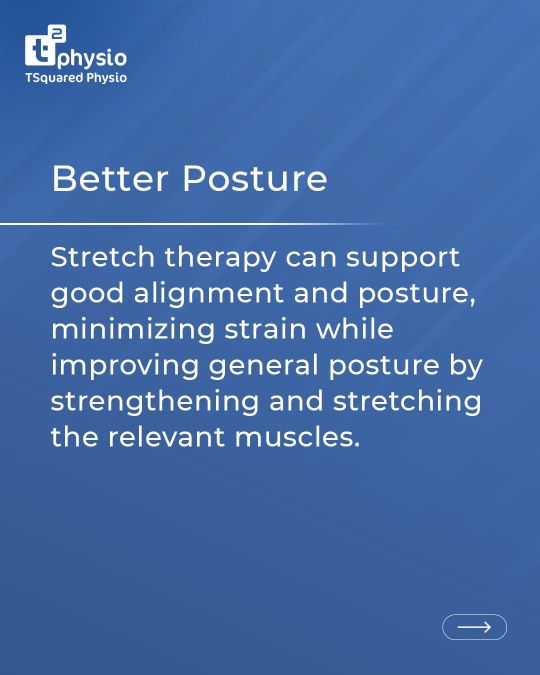
Stretch therapy targets key muscle groups responsible for maintaining proper posture, such as the back, shoulders, and hips. By releasing tension and tightness in these areas, stretching helps correct imbalances and alignment issues, resulting in improved posture and reduced risk of back pain.
Imagine standing tall and proud, with your shoulders back and head held high. Stretch therapy helps you achieve that confident posture, giving you the poise and presence to tackle whatever life throws your way.
Stress Management and Relaxation

Stretching promotes relaxation by triggering the release of endorphins, the body's natural feel-good hormones. This calming effect reduces stress levels and promotes well-being, helping you unwind and de-stress after a long day.
We’ll tell you an easier way to do this. Close your eyes and take a deep breath as you sink into a gentle stretch. Feel the tension melt away from your body, leaving you feeling calm, centred, and ready to take on the world.
Now that you already know about the benefits of stretch therapy, it’s easier for you to get into it. So why wait and waste time? in theapy everyday can get you going good in the long run. Let’s hop into your stretch journey and hope it keeps you well.
0 notes
Text
Consider Mastering Consistency in Stretching
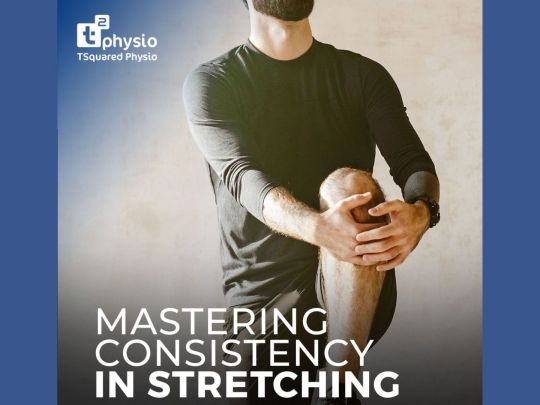
Stretching is not just about touching your toes; it’s a journey towards greater flexibility, mobility, and overall well-being. But unfortunately, it is often overlooked. For people who stretch, half of them don’t understand why and how to do them. The Question, What is stretching? – is often not understood. So today, we’ll tell you about how you can master stretching.
What you must remember is, that to reap the full benefits of stretching, consistency is key. In this blog, we’ll explore the importance of mastering consistency in stretching and how it can transform your body and mind.
How Can You Master Stretching?
This is quite a simple procedure. To master stretching. All it needs you to be is, patient and consistent.
Make it a Habit
Consistency is key to turning stretching into a regular part of your day. When you make it a habit, stretching becomes like brushing your teeth—a natural and effortless part of your routine. This helps ensure that you stick with it over the long term, reaping the benefits of flexibility and mobility.
Set Realistic Goals
Set realistic goals for your stretching journey. Whether it’s reaching for your toes or getting closer to your splits, having achievable targets keeps you motivated and focused. Plus, tracking your progress over time lets you see how far you’ve come, boosting your confidence along the way.
Using Reminders
Incorporating reminders into your daily life can be a game-changer. Whether it’s a cheerful alarm on your phone or colourful sticky notes around your house, these gentle nudges help keep stretching on your radar throughout the day. It’s like having a friendly cheerleader cheering you on!
Mix It Up
Consistency doesn’t mean doing the same old stretches every day. Mixing it up keeps things fun and prevents boredom. Try exploring different types of stretches, from dynamic to static, or even incorporating some yoga poses. Variety is the spice of life, after all!
Listening to Your Body
Consistency also means tuning in to what your body needs. Some days, you might feel super flexible and ready to conquer the world, while other days, you might need to take it easy and focus on gentle stretches. By listening to your body’s signals, you can tailor your stretching routine to suit your needs, avoiding strain and injury along the way.
In conclusion
Mastering consistency in stretching is the secret sauce to unlocking your full flexibility potential. It isn’t as hard as you think it to be. Obviously, the initial stage is going to be tough. You might have issues that might make you feel that stretching is hard but it’s not. The baby steps do count. So, don’t backout because it is getting harder; push yourself to do it everyday till it becomes a habit. And over the top, that’s how you can kickstart on a journey towards greater flexibility, mobility, and overall well-being.
Learn about Stretch Therapy in Singapore.
0 notes
Text
3 Tips on How to Improve Mobility
instagram
Mobility is an essential aspect of a healthy lifestyle, yet it is often overlooked. Maintaining good mobility helps individuals to perform daily activities with ease and reduces the risk of injury. Unfortunately, many people struggle with mobility issues due to a sedentary lifestyle, injuries, or aging. Fortunately, there are several ways to improve mobility, and this article will provide three tips to help individuals enhance their mobility. https://www.instagram.com/p/Cz2P_DlNtOu/?img_index=1 Importance of Mobility Mobility is essential for performing daily activities such as walking, climbing stairs, and reaching for objects. It also plays a crucial role in sports and physical activities, as it allows individuals to move efficiently and effectively. Poor mobility can lead to a range of issues, including pain, stiffness, and limited range of motion. Improving mobility can have numerous benefits, including reducing the risk of injury, improving posture, and enhancing overall physical performance. It can also improve quality of life by making daily activities easier and more comfortable to perform. Incorporating mobility exercises into a regular fitness routine can help improve mobility over time. This can include stretching, foam rolling, and mobility drills. It is important to consult with a healthcare professional before starting any new exercise routine, especially if you have pre-existing medical conditions or injuries. Understanding and improving mobility is essential for maintaining a healthy and active lifestyle. 3 Practical Tips to Enhance Mobility Improving mobility is essential for maintaining a healthy lifestyle. Here are three practical tips that can help enhance mobility. Tip 1: Regularly Practice Stretching Improving mobility starts with a good stretch routine. Regular stretching helps to lengthen muscles, reduce stiffness, and increase your range of motion. Regularly stretching can also reduce the risk of injury. Incorporate dynamic and static stretches into your daily routine to keep your body flexible and functional. Some stretches that can help enhance mobility include: Hamstring stretch Quadriceps stretch Hip flexor stretch Shoulder stretch Neck stretch Tip 2: Strengthen Stabilizer Muscles Strong muscles provide support to your joints, which is essential for mobility. Strengthening these muscles can help improve mobility and reduce the risk of injury. A balanced workout plan can help you maintain muscle mass and prevent age-related muscle loss. Engage in strength training exercises that target the major muscle groups. Some exercises you can start with to help strengthen stabilizer muscles: Plank Side plank Glute bridge Clamshell Wall sit Tip 3: Stay Hydrated and Eat Well Staying hydrated and eating a healthy diet can also help improve mobility. Water is essential for lubricating the joints and preventing stiffness. Eating a diet rich in fruits, vegetables, and lean protein can also help reduce inflammation and promote healthy joints. Visit TSquared Physiotherapy top Learn more.
0 notes
Text
Massage Therapy and the Facts Associated with it

Massage therapy has been used for centuries as a form of healing and relaxation. It involves the of soft tissues in the body to promote physical and mental well-being. While it is often viewed as a luxury, there are many facts associated with massage therapy that make it a valuable and effective form of treatment for a variety of conditions.
Reduce Muscle Tension the Frequency and Intensity of Pain through Regular Massage Therapy Sessions
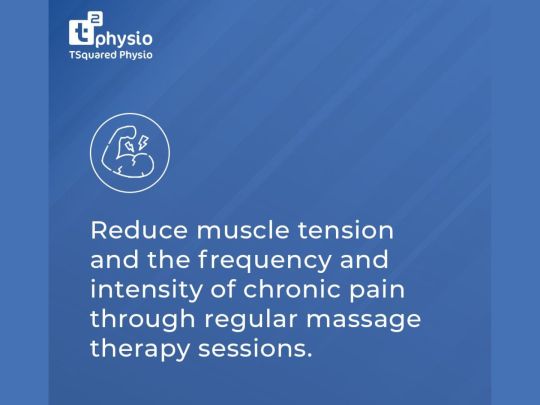
Muscle tension is a common problem that can be caused by a variety of factors, including stress, poor posture, and physical activity. Massage therapy can help to alleviate muscle tension by increasing blood flow to the affected area, promoting the release of endorphins, and reducing the activity of the sympathetic nervous system.
Chronic pain is another common issue that can be caused by a variety of factors, including injury, illness, and stress. Regular massage therapy sessions can help to reduce the frequency and intensity of pain by increasing blood flow to the affected area, promoting the release of endorphins, and reducing inflammation.
Massage therapy can also be used to help manage conditions such as arthritis, fibromyalgia, and chronic fatigue syndrome. By reducing muscle tension and promoting relaxation, massage therapy can help to alleviate the symptoms of these conditions and improve overall quality of life.
Whether you are looking to manage a specific condition or simply promote relaxation and well-being, massage therapy can be a valuable tool in your overall health and wellness routine.
Sound sleep is an essential element of pain management. Massage therapy improves the quality of your sleep.

Quality sleep is crucial for the body to get enough rest to repair and rejuvenate itself. Pain can make it difficult to fall asleep or stay asleep, leading to a vicious cycle of pain and sleep deprivation. Massage therapy is a natural and effective way to improve the quality of your sleep.
Massage therapy helps to relax the body and mind, reducing anxiety and stress levels. This leads to a sound sleep, allowing the body to heal and recover from pain and injuries. Massage therapy also helps to increase the production of serotonin, a hormone that regulates sleep and mood.
Studies have shown that massage therapy can improve the quality of sleep in patients dealing with chronic pain. A 2015 study published in the Journal of Clinical Sleep Medicine found that massage therapy improved sleep quality, decreased pain and anxiety, and increased quality of life in patients with chronic lower back pain.
Massage therapy can also help to improve conditions that can interfere with sleep, such as restless leg syndrome and sleep apnea. By promoting relaxation and reducing muscle tension, massage therapy can help to improve breathing and reduce the symptoms of sleep apnea.
In conclusion, sound sleep is an essential element of pain management, and massage therapy can help to improve the quality of your sleep. Whether you are experiencing chronic pain or have trouble sleeping, massage therapy can provide a natural and effective solution to help you get the that your body needs to heal and recover.
The Release of Endorphins Acts as a Natural Painkiller for the Body. Massage Helps Release Endorphins.

Massage therapy has been used for centuries to relieve pain and promote relaxation. One of the reasons why massage therapy is so effective is because it helps release endorphins, which act as natural painkillers for the body.
Endorphins are chemicals produced by the body that help to relieve pain and promote a feeling of well-being. When you a massage, the pressure applied to your muscles and tissues stimulates the release of endorphins, which can help to reduce pain and promote relaxation.
Massage therapy has been shown to be effective in relieving pain from a variety of conditions, including headaches, back pain, and arthritis. In addition to its pain-relieving effects, massage therapy can also help to reduce stress and anxiety, improve sleep, and promote overall well-being.
If you are looking for a natural way to relieve pain and promote relaxation, massage therapy may be a great option for you. By helping to release endorphins, massage therapy can provide a natural and effective way to manage pain and promote overall health and well-being.
Pain caused by tension, stress, and issues related to anxiety can be managed through massage therapy.
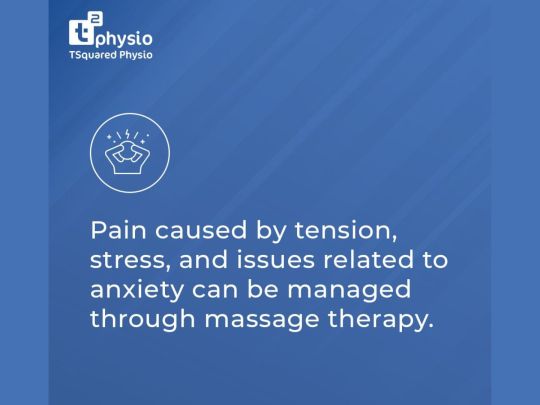
Massage therapy is a non-invasive and natural way to manage pain caused by tension, stress, and anxiety. Many people experience pain in their neck, shoulders, and back due to long hours of sitting at a desk or performing repetitive activities. This pain can be managed through massage therapy, which works by manipulating the soft tissues of the body.
Massage therapy can help reduce muscle tension and stiffness, which can lead to pain and discomfort. It can also help improve circulation and promote relaxation, which can help reduce stress and anxiety levels. Massage therapy can be an effective way to manage pain caused by tension, stress, and anxiety without the need for medication or other invasive treatments.
Massage therapy can be tailored to the individual needs of the client. A skilled massage therapist can use a variety of techniques, such as Swedish massage, deep tissue massage, and trigger point therapy, to address specific areas of pain and discomfort. They can also use different levels of pressure and adjust the massage to the client’s preferences.
Massage therapy can be a safe and effective way to manage pain caused by tension, stress, and anxiety. However, it is important to consult with a healthcare provider before beginning any new treatment, including massage therapy. This is especially important for individuals with chronic pain or other underlying medical conditions.
Enhance the effectiveness of other pain management therapies through massage therapy.
Massage therapy has been found to be an effective complementary therapy for other pain management techniques. It can enhance the effectiveness of other therapies by improving blood circulation, reducing muscle tension, and promoting relaxation.
Massage therapy can be used alongside other pain management therapies such as physical therapy, chiropractic care, and acupuncture. When used in combination with these therapies, massage therapy can help to reduce pain and improve overall function.
Massage therapy can also be used in conjunction with medication for pain management. It can help to reduce the need for pain medication by improving blood circulation and reducing muscle tension, which can help to alleviate pain.
In addition to enhancing the effectiveness of other pain management therapies, massage therapy can also help to improve overall well-being. It promotes relaxation, reduces stress, and can help to improve sleep quality. This can lead to a reduction in pain and an improvement in overall quality of life.
massage therapy can be a valuable tool in the management of pain. It can enhance the effectiveness of other pain management therapies and improve overall well-being. If you are experiencing pain, consider incorporating massage therapy into your pain management plan.
0 notes
Text
Similarities an Differences of Tennis Elbow and Golfer Elbow

Tennis Elbow is overloading of the extensor tendon that attaches onto the outside of the elbow.
Golfer Elbow is overloading of the flexor tendon that attaches onto the inside of the elbow.
DIFFERENCES:

SIMILARITIES:
› These injuries start gradually and can get worse with time.
› They are caused by repetitive wrist and elbow movements.
› Inflammation of the tendons is experienced in both cases, which can result in partial or full-thickness tears.
HOW CAN PHYSIOTHERAPY HELP?
› Aid in tissue healing and restoration
› Regain your natural range of motion
› Reduce swelling and discomfort
› Get you back to the game
0 notes
Text
Do You Feel Your Functional Mobility Has Decreased?

In today's fast-paced world, maintaining an active lifestyle is more important than ever. However, many of us find our movements restricted, our activities limited, and our quality of life diminished. The question then arises: What's holding us back? The answer, more often than not, lies in something we tend to overlook—flexibility.
The Hidden Culprit: The Lack of Flexibility
Flexibility, or the ability of our muscles and joints to move through their full range of motion, is the unsung hero of our daily lives. It's what allows us to perform basic activities like bending to tie our shoes, reaching for items on a high shelf, or twisting to look behind us. Yet, it's easy to take this crucial ability for granted—until it starts to wane.
The decrease in functional mobility, the ease with which we carry out our day-to-day tasks, can often be traced back to a decline in flexibility. This limitation not only hampers our ability to perform simple tasks but can also lead to a cascade of negative effects on our overall health and well-being.
The Impact of Neglecting Flexibility
Ignoring the importance of flexibility can have far-reaching consequences. Without regular stretching and flexibility exercises, our muscles become shorter and tighter, leading to decreased mobility, discomfort, and a higher risk of injuries. This lack of flexibility can also contribute to poor posture, back pain, and strains in various parts of the body, further limiting our ability to move freely and efficiently.
Reclaiming Your Mobility
The good news is that it's never too late to improve your flexibility and, by extension, your functional mobility. Incorporating simple, daily stretching routines into your life can make a significant difference. Stretching not only enhances flexibility but also improves blood circulation, boosts oxygen levels, and helps reduce stress.

Stay Tuned for Life-Changing Tips
Recognizing the pivotal role flexibility plays in our overall health and functional mobility is the first step towards a more active and unrestricted life. In the coming days, we will share a series of practical tips and exercises designed to enhance your flexibility. These insights will not only help you regain control over your daily activities but also improve your posture, reduce the risk of injuries, and increase your overall sense of well-being.
Whether you're an avid athlete looking to improve your performance or someone simply seeking to ease the stiffness that comes with age or a sedentary lifestyle, these upcoming tips will be invaluable. From targeted stretches to comprehensive flexibility routines, we'll guide you through effective strategies to boost your flexibility and unlock your body's full potential.
Stay tuned as we embark on this journey to enhanced flexibility and improved functional mobility. Together, we'll explore how to reclaim the freedom of movement that is so essential to our quality of life, ensuring that you can bend, reach, and twist with ease and confidence.
Visit TSquared Physiotherapy for more tips.
0 notes
Text
9 Tips to Get the Most Out of Your Therapist

When seeking therapy, whether it's physiotherapy, counseling, or any other form of professional support, it's important to actively engage in the process to maximize the benefits. By taking a proactive approach and following some key tips, you can ensure that you get the most out of your therapist. In this article, we will explore nine valuable tips to help you make the most of your therapeutic experience and achieve your desired outcomes.

1. Define Your Goals and Prioritize What Matters to You:
Before starting therapy, take the time to define your goals and what you hope to achieve. By identifying your priorities, you can better communicate your expectations to your therapist, allowing them to tailor the treatment plan accordingly.
2. Find a Therapist Suitable for You:
It's essential to find a therapist who aligns with your needs and preferences. Research different therapists, read reviews, and consider their areas of expertise. A good therapeutic relationship is built on trust, empathy, and mutual respect.
3. Discuss the Feasibility of Your Fitness Goals with Your Therapist:
If your therapy involves fitness or physical goals, have an open discussion with your therapist about the feasibility and timeline of achieving those goals. They will provide guidance on setting realistic expectations and work with you to develop a suitable plan.
4. Plan a Program to Achieve Those Goals:
Collaborate with your therapist to develop a personalized program that aligns with your goals. This may include specific exercises, treatment modalities, or lifestyle adjustments. A well-structured plan will keep you focused and motivated.
5. Stick to the Program and Work Actively Towards Achieving Expected Results:
Consistency is key to success. Commit to your therapy program and follow it diligently. Attend all scheduled sessions and actively engage in the recommended activities or exercises. Your therapist will guide and support you throughout the process.
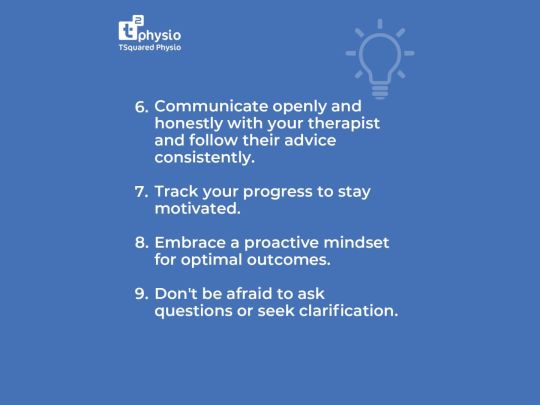
6. Communicate Openly and Honestly with Your Therapist:
Establish open and honest communication with your therapist. Share your progress, concerns, or any changes in your condition. This feedback will enable your therapist to make necessary adjustments and ensure the treatment remains effective.
7. Track Your Progress to Stay Motivated:
Keep a record of your progress, whether it's improvements in physical function, emotional well-being, or achieving specific milestones. Tracking your progress will serve as a motivating factor and reinforce the positive changes that therapy is bringing into your life.
8. Embrace a Proactive Mindset for Optimal Outcomes:
Take an active role in your therapy. Implement the strategies or techniques suggested by your therapist outside of sessions. Practice self-care, follow lifestyle recommendations, and incorporate therapeutic exercises into your daily routine. Your commitment will contribute to better outcomes.
9. Don't Be Afraid to Ask Questions or Seek Clarification:
Therapy can sometimes be complex, and it's natural to have questions or seek clarification. Don't hesitate to ask your therapist for further explanation or guidance. Understanding the therapeutic process will enhance your engagement and ensure you make the most of your sessions.
Conclusion:
Getting the most out of your therapist requires active participation and collaboration. By defining your goals, finding the right therapist, planning and sticking to a program, communicating openly, tracking progress, embracing a proactive mindset, and seeking clarification when needed, you can optimize the benefits of therapy and work towards achieving your desired outcomes. Remember, therapy is a journey, and your commitment and active involvement will significantly contribute to your overall success.
Read more:
Posture and Pain: Unveiling the Complex Connection
The Process of Treating an Injury: A Physiotherapist’s Approach
0 notes
Text
The Process of Treating an Injury: A Physiotherapist’s Approach
When it comes to treating injuries, physiotherapists play a vital role in helping individuals recover and regain their physical well-being. They follow a structured process that involves assessing the issue, collaborating with the patient, developing a treatment plan, monitoring progress, and maintaining effective communication. In this article, we will explore the steps involved in a physiotherapist’s process to treat an injury, highlighting the importance of individualized care and goal attainment.
1. Assess the Issue, Injury, or Problem(s):
The first step in the physiotherapist’s process is to thoroughly assess the patient’s condition. This includes understanding the nature of the injury, identifying contributing factors, and evaluating any related issues. Through physical examination, movement analysis, and diagnostic tests, the physiotherapist forms a working diagnosis, providing a foundation for further treatment planning.
2. Get to Know Your Patient:
Building a strong rapport with the patient is essential for effective treatment. Physiotherapists take the time to listen to their patients, understanding their preferences, worries, goals, and expectations. This holistic approach helps create a trusting relationship and ensures that the treatment plan aligns with the patient’s individual needs and aspirations.
3. Begin a Valid, Evidence-Informed Collaborative Plan:
Based on the assessment and understanding of the patient’s goals, the physiotherapist develops a personalized treatment plan. This plan draws from evidence-informed practices, combining manual therapies, therapeutic exercises, modalities, and other techniques tailored to the patient’s specific needs. The physiotherapist guides the patient through the plan, setting realistic milestones and adapting as necessary.
4. Consider Each Progression: Adopt, Re-assess & Move Through Setbacks:
Treatment progress is not always linear, and setbacks may occur. Physiotherapists understand the importance of adapting to these challenges and continuously re-assessing the patient’s response to treatment. They adjust interventions, modify exercises, or incorporate new techniques as needed to optimize healing and rehabilitation. This iterative approach ensures that the treatment plan remains dynamic and effective.
4. Consistent Communication:
Communication is a cornerstone of successful physiotherapy treatment. Physiotherapists maintain open lines of communication with their patients, providing education about the injury, explaining treatment options, and addressing any concerns or questions. They also collaborate with other healthcare professionals involved in the patient’s care to ensure a comprehensive and integrated approach to treatment.
5. Attain Patients’ Goals:
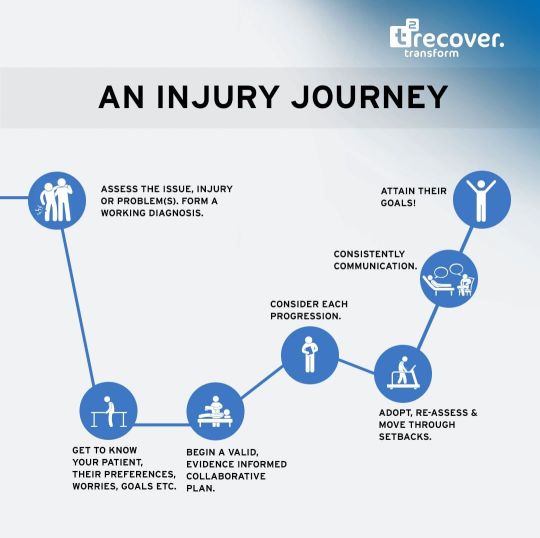
Conclusion:
Physiotherapists follow a systematic and patient-centered process to treat injuries. From assessing the issue and forming a working diagnosis to developing collaborative treatment plans, adapting interventions, and maintaining consistent communication, their approach is focused on individualized care and goal attainment. By combining expertise, evidence-informed practices, and patient collaboration, physiotherapists play a crucial role in helping individuals recover, regain function, and enhance their overall well-being.
0 notes
Text
Posture and Pain: Unveiling the Complex Connection

There are so many myths about posture and pain existing together but most of the time, it is untrue. While it is easy to draw a straight line between slouching at a desk and the discomfort in our backs, science tells us a different story.
The factors that influence pain are:
There can be existing genetic dispositions that might cause such pain
Lifestyle choices shape the way your pain affects your body it can be unhealthy consumption of food too!
What may cause pain in you, might not cause pain in another person- it also differs from individual to individual.
Such posture pain issues can actually be relieved by working in ergonomic workspaces, taking regular breaks from work, doing yoga or pilates, maintaining a healthy sleeping posture, and practising strengthening exercises. If the pain increases to an unbearable amount, you can go for targeted exercises, use the help of stress management solutions or the best of everything- go for physical therapy for instant relief.
Since everyone is built in a different way, you need a customised solution when it comes to relieving your pain problems. Not everyone goes through the same thing. Moreover, choosing tailor-made plans can help you understand your mechanisms much better.
Learn more at TSquared Physiotherapy Blog.
1 note
·
View note
Text
A Brief Guide to Keeping Your Tendons Healthy

Tendons play a crucial role in our musculoskeletal system, connecting muscles to bones and allowing us to move efficiently. However, they are prone to injury and can become a source of pain and limitation if not properly cared for. In this article, we will explore some essential tips to keep your tendons healthy and functioning optimally, allowing you to maintain an active and pain-free lifestyle.
Appropriate Resistance Training:
Engaging in regular resistance training is beneficial for building strength and maintaining healthy tendons. However, it’s essential to approach training with caution and ensure proper technique and form. Gradually increase the intensity and weight of your workouts to give your tendons time to adapt and strengthen. Consult with a qualified fitness professional to design a balanced and progressive training program tailored to your needs.
Avoid Sudden Exercise Spikes:
Rapid increases in exercise intensity or volume can place excessive stress on your tendons, increasing the risk of injury. Whether you’re starting a new exercise routine or returning to physical activity after a break, it’s crucial to gradually progress and allow your tendons to adjust. Listen to your body and pay attention to any signs of discomfort or pain. If you experience persistent pain, seek guidance from a healthcare professional.
Don’t Let Them Do Nothing!

Avoid Gaining Excess Body Fat:
Maintaining a healthy weight is important for overall health, including tendon health. Excess body fat can increase the load and stress placed on tendons, potentially leading to overuse injuries. Focus on maintaining a balanced diet, rich in whole foods, and engage in regular physical activity to help manage your weight and reduce unnecessary strain on your tendons.
Maintain a Healthy Diet:
Nutrition plays a vital role in the health of your tendons. Consume a well-rounded diet that includes a variety of nutrients, such as lean proteins, whole grains, fruits, and vegetables. These nutrients provide the building blocks for tendon repair and help maintain their strength and resilience. Stay adequately hydrated as well, as dehydration can affect tendon elasticity and increase the risk of injury.
Have a Trusted Coach/Plan Physio:
Working with a qualified coach or a plan physiotherapist can be invaluable in maintaining tendon health. They can provide guidance on proper training techniques, help develop a personalized exercise program, and address any imbalances or weaknesses that may put stress on your tendons. A knowledgeable professional can also monitor your progress, make necessary adjustments, and provide strategies for injury prevention and rehabilitation.
Conclusion:
Keeping your tendons healthy is essential for maintaining an active lifestyle and preventing injuries. By following these guidelines, including appropriate resistance training, avoiding sudden exercise spikes, staying active, managing weight, maintaining a healthy diet, and seeking professional guidance, you can support the health and longevity of your tendons. Remember to listen to your body, prioritize gradual progression, and seek medical advice if you experience persistent pain or discomfort. Taking care of your tendons will contribute to your overall physical well-being and allow you to enjoy the activities you love for years to come.
0 notes
Text
your hip flexors need love too 🫶
wearing @alphalete amplify shorts in chai & classic crew in willow
code VICKY to save 10% ✨
©️Credit ig @vickyplamenova
exercises in order shown
• shinbox into pistol
• standing kb raises
• deep squat slider pistols
• shinbox leg sweeps over kb
• slider cossack to pistol sweeps
• leg lifts over kb
#Beautiful #fit #woman #fashion #gym #fitnessmotivation #fitness #FindYourBalance #sportgirl #lifestyle #motivationmonday #happy #fitnessaddict #selfie #home #love #workout #work #workinprogress #fitnessgirl #glute #glutes #glutworkout #squats #gymrat #legday #leg #legs #strong #fitnessmodel
364 notes
·
View notes
Text
Learn How Massage Therapy Can Alleviate Lower Back Pain

Lower back pain is a common ailment that affects people of all ages and lifestyles. It can be debilitating, limiting our mobility and impacting our overall quality of life. While there are various treatment options available, one alternative therapy that has gained recognition for its effectiveness in relieving lower back pain is massage therapy. In this article, we will explore the benefits of massage therapy and how it can provide relief and support for those suffering from lower back pain.
Understanding Lower Back Pain
Before delving into the role of massage therapy, it’s important to understand the underlying causes of lower back pain. Common factors contributing to lower back pain include muscle tension, poor posture, injury, or underlying medical conditions. The lower back is a complex area consisting of muscles, ligaments, and vertebrae, and any imbalance or strain in this region can lead to discomfort and pain.
How Massage Therapy Can Help
Muscle Relaxation and Tension Release:
Massage therapy targets the muscles in the lower back, helping to alleviate muscle tension and reduce tightness. Skilled massage therapists employ various techniques, such as Swedish massage, deep tissue massage, or myofascial release, to promote relaxation, increase blood flow, and release built-up tension in the muscles. By loosening tight muscles, massage therapy can significantly reduce lower back pain and restore mobility.
Improved Circulation and Nutrient Delivery:
Massage therapy enhances blood circulation in the affected area, ensuring that essential nutrients and oxygen reach the muscles and tissues in the lower back. Improved circulation not only promotes faster healing but also helps to reduce inflammation and swelling. By optimizing the delivery of vital nutrients, massage therapy supports the body’s natural healing process and aids in pain relief.
Increased Range of Motion and Flexibility:
Chronic lower back pain can restrict our range of motion and limit our ability to perform daily activities. Through targeted massage techniques, therapists can help restore flexibility and improve range of motion in the lower back. By focusing on specific muscles and joints, massage therapy works to alleviate stiffness, increase flexibility, and enhance overall mobility.
Stress Reduction and Relaxation:
Prolonged lower back pain can take a toll on our mental and emotional well-being. Massage therapy provides a holistic approach by not only targeting the physical aspects but also addressing stress and tension associated with chronic pain. The soothing touch and tranquil environment of a massage session promote relaxation, reduce anxiety, and release endorphins, promoting an overall sense of well-being.
Conclusion:
Massage therapy offers a safe and non-invasive approach to managing lower back pain. Through its various techniques, it provides targeted relief, improves circulation, increases flexibility, and promotes relaxation. While massage therapy can provide significant relief, it’s important to consult with a qualified massage therapist or healthcare professional to develop a personalized treatment plan. Whether you’re experiencing acute or chronic lower back pain, considering massage therapy as part of your pain management strategy can bring you closer to a pain-free and more comfortable life.
0 notes
Text

🌟 Unlock the Path to a Healthier You with Physical Therapy! 🌟
Are you tired of living with pain and discomfort? Struggling with mobility issues? Before you consider surgery or long-term medication, have you thought about physical therapy? 🤔
👉 What You Will Learn After Reading Our Latest Blog Post:
1️⃣ What is Physical Therapy?
- Understand the core principles and how it can restore your physical function.
2️⃣ Physical Therapy vs Physiotherapy
- Learn why these terms are often used interchangeably and what they mean in the Singaporean context.
3️⃣ How Does It Work?
- Discover TSquared Physiotherapy’s personalized approach to healing and rehabilitation.
4️⃣ Multifaceted Benefits
- From pain reduction to mental well-being, the advantages are numerous.
5️⃣ Diverse Treatment Approaches
- Get insights into specialized techniques like Musculoskeletal Physiotherapy, Post-Operative Rehabilitation, and more.
🌱 Physical therapy is not just a treatment; it’s a lifestyle change that empowers you to take control of your well-being. 🌱
👇 Don’t Miss Out! Dive into our comprehensive guide now! 👇
🔗 Guide to Physical Therapy in Singapore
🌟TSquared Physiotherapy: Your Partner in Holistic Healing and Comprehensive Care. 🌟
0 notes